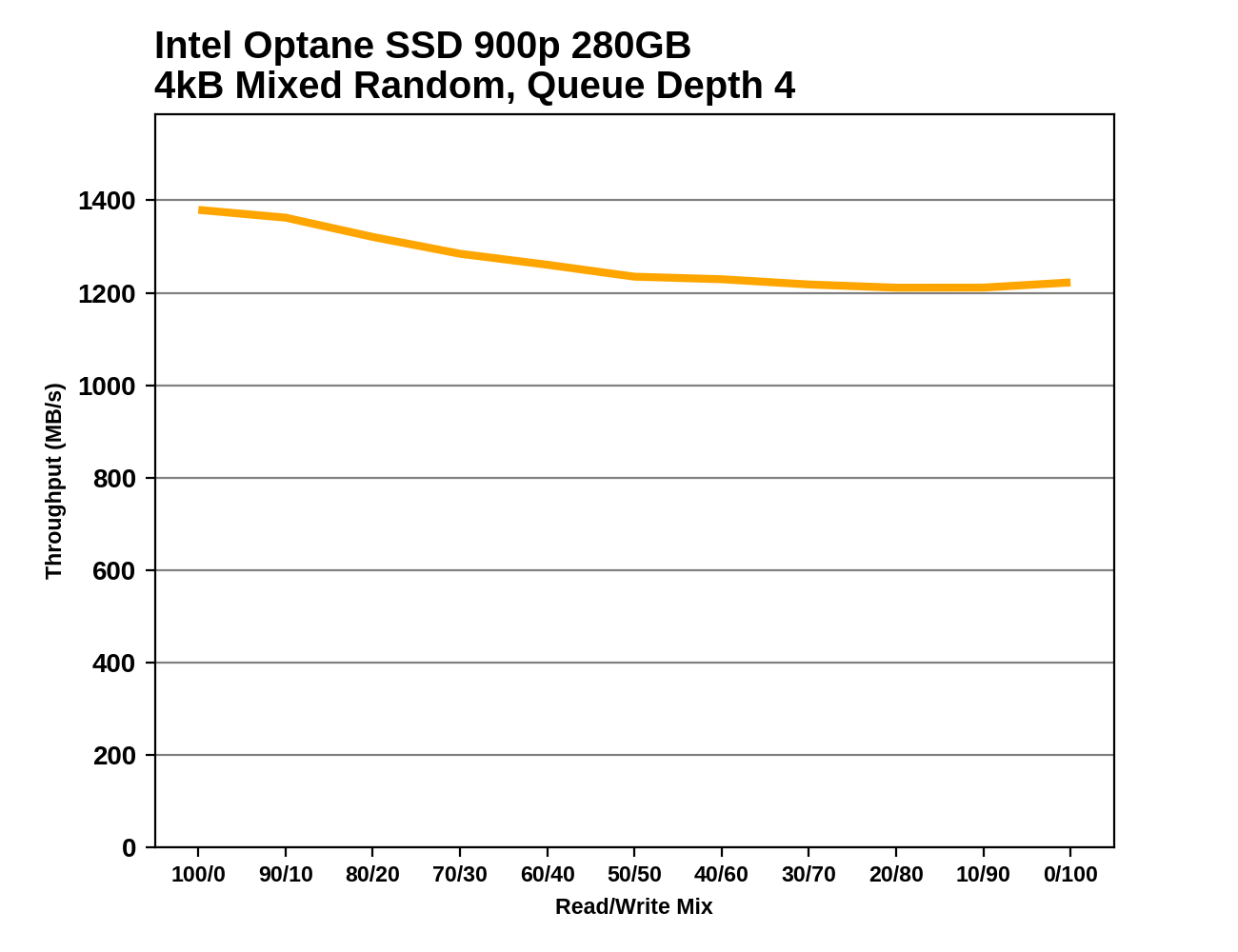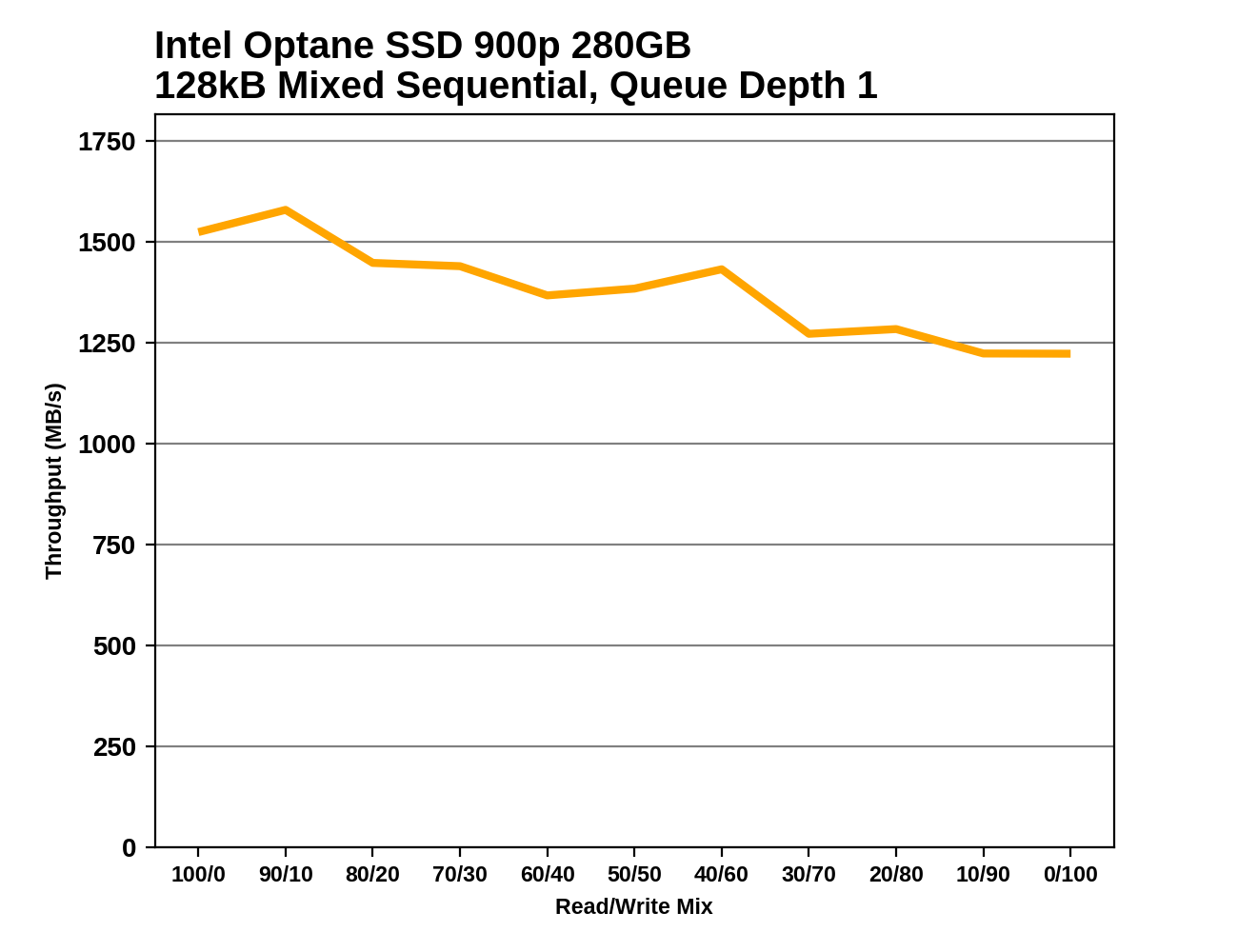The Intel Optane SSD 900P 280GB Review
by Billy Tallis on October 27, 2017 9:30 AM ESTMixed Random Performance
Our test of mixed random reads and writes covers mixes varying from pure reads to pure writes at 10% increments. Each mix is tested for up to 1 minute or 32GB of data transferred. The test is conducted with a queue depth of 4, and is limited to a 64GB span of the drive. In between each mix, the drive is given idle time of up to one minute so that the overall duty cycle is 50%.

The mixed random I/O performance of the Intel Optane SSD 900P is completely unmatched. The small Optane Memory M.2 is the second fastest drive we've tested, and the fastest flash-based SSD is only a third as fast as the Optane SSD overall.
 |
|||||||||
At the very end of the test, when the workload shifts to pure random writes, Samsung's fastest SSDs are able to batch the writes and dramatically improve throughput, almost enough to catch up to the slowest speed the Optane SSD hits during this test.
Mixed Sequential Performance
Our test of mixed sequential reads and writes differs from the mixed random I/O test by performing 128kB sequential accesses rather than 4kB accesses at random locations, and the sequential test is conducted at queue depth 1. The range of mixes tested is the same, and the timing and limits on data transfers are also the same as above.

The Intel Optane SSD 900P doesn't quite dominate the mixed sequential I/O test to the extent that it trounced the competition in the mixed random I/O test, but it still breaks the record with a 40% higher average throughput than the fastest flash-based SSD.
 |
|||||||||
The Optane SSD 900P's performance wavers a bit as the workload changes, but the general trend is a gradual reduction in performance as the proportion of writes increases. The flash-based SSDs tend to show an sharper decline in performance during the first half of the test, and the good ones recover most of that performance over the course of the second half. But the low performance in the middle of the test brings the averages way down and leaves the Optane SSD alone at the top.










205 Comments
View All Comments
Hurr Durr - Friday, October 27, 2017 - link
He desperately needs some CNC time to calm down, be merciful.Reflex - Friday, October 27, 2017 - link
We need to compile a list of all the things you supposedly have been doing. I mean seriously, anything anyone brings up as a use case supposedly you've been doing forever at a professional level. And you use that imagined position to then attempt to clobber their own assertions about its applicability in the field they are discussing.ddriver - Friday, October 27, 2017 - link
What can I say, I am a renaissance man. Also known as a polymath. I have scores of interests in all sorts of fields or science, arts and crafts, and I have employed many of those to make a living over the years. Where you collect pokemons, or postal stamps, or baseball hats or whatever, I collect skill and knowledge. Even the act of commenting here is part of my studies, social and psychological.Reflex - Friday, October 27, 2017 - link
Not only have you pursued your 'scores' of interests, you are the expert in all of them! We are truly gifted by your presence, I cannot wait to read your memoirs....MarceloC - Friday, October 27, 2017 - link
"What can I say, I am a renaissance man. Also known as a polymath. I have scores of interests in all sorts of fields or science, arts and crafts, and I have employed many of those to make a living over the years. Where you collect pokemons, or postal stamps, or baseball hats or whatever, I collect skill and knowledge. Even the act of commenting here is part of my studies, social and psychological."LOL LOL LOL!
sor - Friday, October 27, 2017 - link
You clearly don’t care about immediate persistence, consistent performance, or random reads.The numbers make a clear argument that Optane won’t be all that helpful for light workloads, but we already expected that; there’s only so much super fast IO can do for you if you’re not using IO.
I’d say those insane random reads and improved latencies live up to 3D Xpoint. There may be some elements to improve on but it is clear we are looking at a different, superior tech at a cost that is surprisingly affordable. Much of the initial talk about Xpoint was around whether or not it was real, if it was a hyped twist on regular flash, it seems clear it is a different animal.
ddriver - Friday, October 27, 2017 - link
You clearly didn't pay attention to what I've written. I did indeed acknowledge the random reads as an obviously strong point.Judging by the "destroyer", it won't be that helpful in heavy workloads either. In fact, contrary to what you say, where it shines the most is exactly light workloads, which is what low QDs are. Push higher queue depths and NVME catches up.
Lolimaster - Saturday, October 28, 2017 - link
With most work using big files, 4k random performance is meaningless, everything is linear so huge sustained write/reads are prefered. 960EVO/Pro wins.ionstorm66 - Sunday, October 29, 2017 - link
I wonder how much more performance that same test system would get if it had 128GB of ram. The 900P 280GB is 389 bucks, 64GB kit of ram is 500 bucks. I'd take 64GB of system memory over 280gb of ssd storage anyday, especially with a system with a 960 pro already.mapesdhs - Tuesday, October 31, 2017 - link
Unless of course you're doing something that needs ECC, in which case that cost comparison is rather wide of the mark.